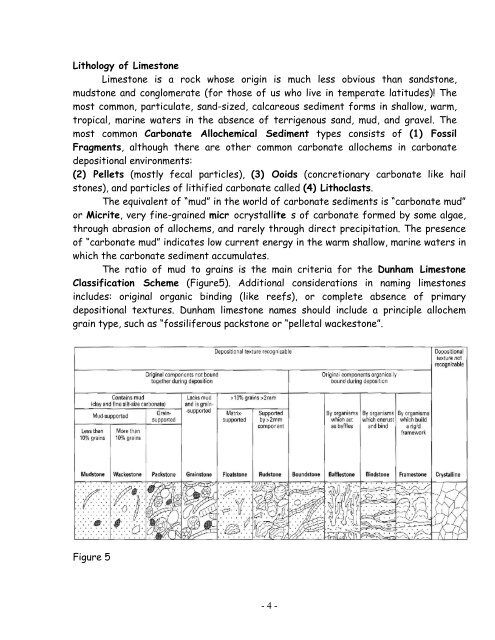Sedimentary Rocks II
Sedimentary Rocks II
Sedimentary Rocks II
You also want an ePaper? Increase the reach of your titles
YUMPU automatically turns print PDFs into web optimized ePapers that Google loves.
Lithology of Limestone<br />
Limestone is a rock whose origin is much less obvious than sandstone,<br />
mudstone and conglomerate (for those of us who live in temperate latitudes)! The<br />
most common, particulate, sand-sized, calcareous sediment forms in shallow, warm,<br />
tropical, marine waters in the absence of terrigenous sand, mud, and gravel. The<br />
most common Carbonate Allochemical Sediment types consists of (1) Fossil<br />
Fragments, although there are other common carbonate allochems in carbonate<br />
depositional environments:<br />
(2) Pellets (mostly fecal particles), (3) Ooids (concretionary carbonate like hail<br />
stones), and particles of lithified carbonate called (4) Lithoclasts.<br />
The equivalent of “mud” in the world of carbonate sediments is “carbonate mud”<br />
or Micrite, very fine-grained micr ocrystallite s of carbonate formed by some algae,<br />
through abrasion of allochems, and rarely through direct precipitation. The presence<br />
of “carbonate mud” indicates low current energy in the warm shallow, marine waters in<br />
which the carbonate sediment accumulates.<br />
The ratio of mud to grains is the main criteria for the Dunham Limestone<br />
Classification Scheme (Figure5). Additional considerations in naming limestones<br />
includes: original organic binding (like reefs), or complete absence of primary<br />
depositional textures. Dunham limestone names should include a principle allochem<br />
grain type, such as “fossiliferous packstone or “pelletal wackestone”.<br />
Figure 5<br />
- 4 -

















